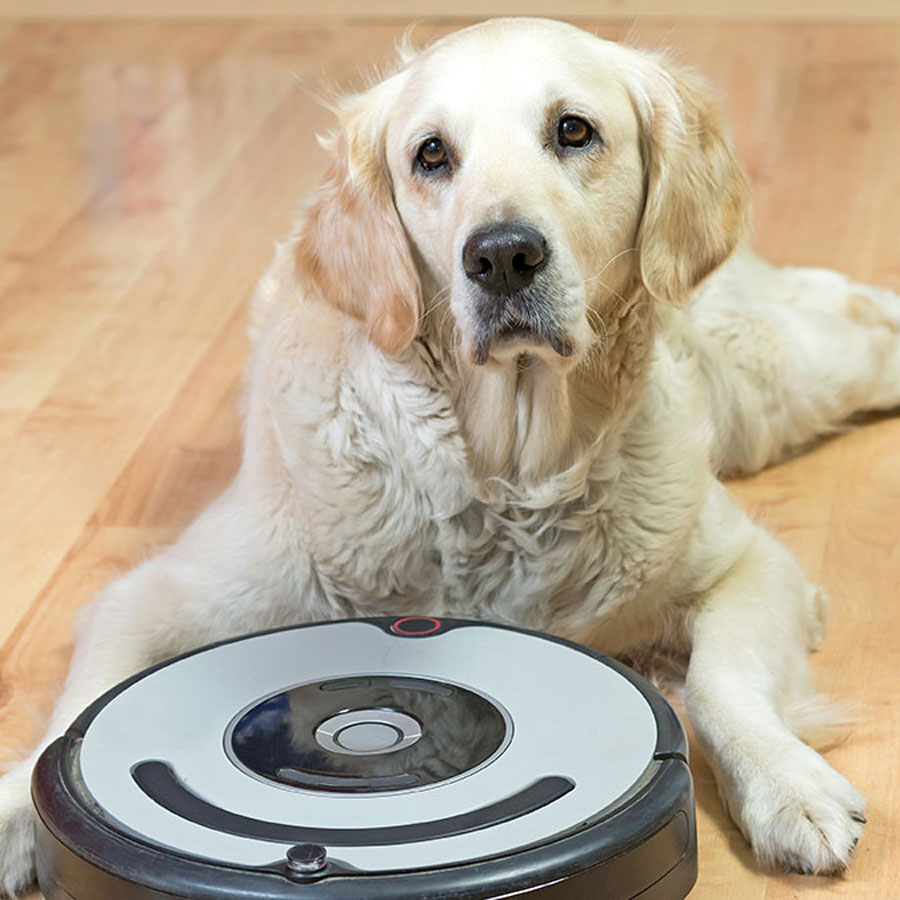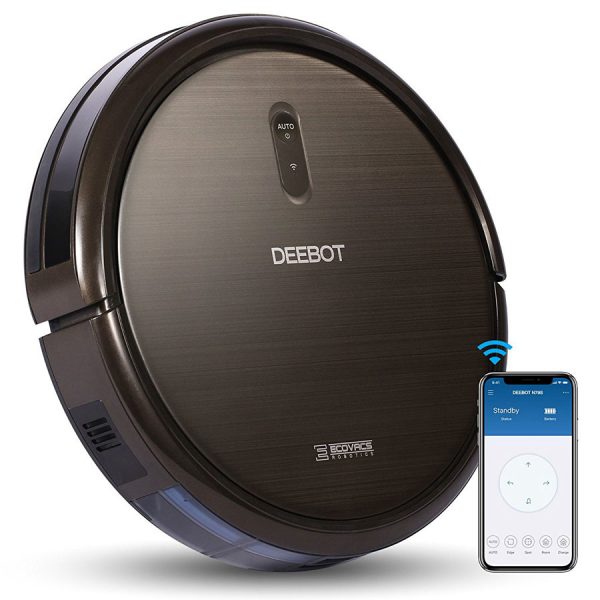The primary concern of any pet owner when choosing a vac is – do robot vacuums work for dog hair.
The short answer is “yes.” Most robot vacuums do a decent job of picking up dog hair, but some are better for households with pets.
Any dog owner will admit a robot vacuum is a life-saving solution, but you must pick the correct model and take proper care of the appliance to prevent its damage.
The best robot vacuum for dog hair must have a high dust bin capacity, powerful suction, smart navigation, and wide rubber brushes. Most modern robot vacs fit these criteria.
You can significantly prolong your robot vac’s lifespan by cleaning the brushes, emptying the dustbin, and replacing the filter regularly.
Can Pet Hair Damage a Robot Vacuum?
The short answer for whether robot vacuums can pick up pet hair is – yes. But does pet hair damage a robot vacuum? Will your robot vac die sooner if you have a long-haired dog or cat?
The answer depends on your vac’s model, your pet’s shedding intensity, and how well you take care of the appliance. Dog hair can do a lot of damage to your robot vacuum, but you can prevent it.
Any robot vacuum inevitably picks up hair. We shed daily, so some of your hair, short or long, will end up tangled in the brushes. Robot vacuums are designed to handle an average amount of hair just fine.
However, some dog breeds shed significantly more than humans, so the job is more challenging for the vac. A robot vacuum full of hair can destroy its own gearbox, and long hair tangled in brushes can prevent the robot from picking up debris.
Pet hair can also get stuck in the wheels and hinder driving or cover the camera, intervening in navigation. Fortunately, you can avoid these problems with timely servicing.
How to Choose a Robot Vacuum for Dog Hair
Although most modern robot vacuums are suitable for pet hair, some aren’t the best choice for dog owners. If you have a short-haired dog or it doesn’t shed much, say, Jack Russel Terrier or Yorkshire Terrier, you can pick any robot vacuum.
However, if you have a long-haired or heavy-shedding dog, avoid vacs with narrow brush heads. Such robot vacuums can only pick up so much hair until the brushes stop working.
Instead, choose a robot vacuum with wide brush heads like those in traditional vacuums because they are better at dealing with clumps of fur. Wide brush heads are good at picking even hair stuck in high-pile carpets.
Consider robot vacuums with rubber cylinders rather than traditional bristle brushes if you have a long-haired dog. One vacuum with such brushes is Roomba 890.
It has two thread-covered rubber cylinders with AeroForce technology that sucks in dog hair without getting it tangled in bristles. The concept is similar to that of the Dyson Airwrap hair styling tool.
Such rubber brushes are also easier to clean than traditional bristle brushes, saving you time. Another point to consider when choosing a robot vacuum for pet hair is suction power.
The average robot vacuum suction power is around 1500-2000 pa, which is sufficient for short or medium dog hair. However, robot vacuums need more suction power to pick up dog hair from carpets than hardwood floors because hairs get stuck.
If you have high-pile carpets or your dog sheds heavily, look for a robot vacuum with 3000-4000 pa suction power, like Xiaomi Mop 2 Pro. Such robot vacs will also pick up clay litter particles and kibble.
Note that even the most powerful robot vacuums don’t pick up dog hair from high-pile carpets as effectively as traditional vacuums. You will still need to clean your carpets with a handheld vacuum occasionally.
You might find robot vacs with a dry mop attachment handy if your dog sheds in clumps. The mop sweeps debris, easing the job for bristle brushes.
Robot vacuums with a wet mopping feature usually do a better job picking up dog hair. You can get one relatively cheap and save a lot of time on house chores.
Navigation is crucial for any robot vacuum, especially if you have pets. The best robot vacuums for pet owners must detect dog bowls, toys, and poop to avoid causing a mess.
Lastly, ensure that the robot vacuum has a high dust bin capacity. For example, older Roomba models only hold 300 ml of debris, whereas some vacs can hold over 600 ml.
The ability to work quietly is an advantage for many pet owners because some dogs fear the vacuum’s noise. Ideally, choose a slim D-shaped model that can fit into corners and under the couch where dog fur tends to collect.
If your dog sometimes poops in the house or leaves small toys around, pick an intelligent robot vacuum that can detect such obstacles.
Consider a Self-Emptying Base
Even with a high dust bin capacity, you must empty your robot vac more frequently if you have a dog. The more your dog sheds, the more often you must clean the dustbin.
How often to empty a robot vacuum depends on many factors. Most people empty the bin every two or three cycles, but pet owners might need to clean it every cycle or several times throughout one vacuuming session.
Consider a robot vacuum with a self-emptying base, like Roomba s9+, Deebot X1 OMNI, or Roborock S7 MaxV Plus to save time. Such robot vacs are self-sufficient and don’t need your help in emptying the dustbin.
You will still need to empty the base container occasionally, but nowhere as frequently as if your robot vac didn’t have the base.
Depending on the robot vac’s model and your dog’s shedding intensity, you might need to empty the base every 20 to 90 days. Such robot vacuums are more expensive, but any pet owner will admit they are worth it.
How to Make Your Robot Vacuum Last Longer If You Have Pets
Assuming you’ve already picked the right robot vacuum for dog hair, learn how to make a robot vacuum last longer if you have pets.
You can always ease the strain on your robot vacuum by sweeping the floor with a regular broom beforehand.
The less dog hair ends up in the dustbin, the less frequently you’ll need to empty it. Plus, hair won’t get wrapped around the brushes.
Remember to clean the brushes after every vacuuming cycle. If you neglect it, your robot vacuum will be unable to move around and pick up debris.
Regularly replace the filter. When the filter is clogged, the robot vacuum can’t use its full suction power. As a result, it isn’t as effective at picking up large clumps of fur and other heavy debris.
A full dust bin also prevents your robot vacuum from picking up dog hair. Apart from taking care of your robot vacuum, take care of your dog.
Don’t forget to groom your dog. Brush your dog daily or weekly, depending on its breed, haircut, and shedding season. This way, you remove clumps of shed fur stuck in the coat, preventing them from falling on the floor, and reduce the load on your vacuum.
You might wonder how to clean a robot vacuum from pet hair. Many modern robot vacs have a self-cleaning feature where they spin brushes in reverse, pushing all the fur clumps off.
If your vac doesn’t have such a feature or longer hairs are wrapped around the brushes, use scissors or a cleaning tool that looks like a mail opener.
Lastly, maintain a cleaning schedule. Your robot vacuum will have more work if you only run it occasionally, and the bin will quickly get full. Run your robot vacuum daily or once in two days to reduce the load at each cleaning session.
Why Doesn’t My Vacuum Pick Up Dog Hair?
You might wonder why your robot vacuum doesn’t pick up dog hair. First, check the brushes to ensure they are spinning freely. If you see any long hair tangled in bristles, remove it.
Second, check the filters to make sure they aren’t clogged. Third, empty the dustbin. If your robot vacuum doesn’t pick up pet hair after this basic troubleshooting, the problem might lie in your dog’s fur and flooring color.
Robot vacuums use sensors or cameras to navigate and detect debris on the floor. Some robot vacuums might have difficulty spotting dog hair if it matches the color of the floor or carpet.
Plus, many robot vacs avoid dark surfaces because they mistake them for a cliff. Sensors also help robot vacs detect whether the dust bin is full. If the sensor is dirty or faulty, the robot might stop working.
Lastly, your robot might not be picking up dog hair and other debris because of a dirty gearbox. Wipe the cleaning head module of dust and debris to solve the issue.
Sources
- littlerobotshop.com/is-a-roomba-good-for-cleaning-dog-hair/
- eu.usatoday.com/story/tech/reviewedcom/2019/10/16/best-robot-vacuums-pet-hair-2019-neato-irobot-roomba-more/3995692002/
- www.bestbuy.com/site/shop/best-robot-vacuum-for-dog-hair
- retrievist.akc.org/reviews/best-robot-vacuums-for-pet-hair/
- allaboutcats.com/reviews/best-robot-vacuum-for-pet-hair
- www.caninejournal.com/best-robot-vacuum-for-pet-hair/

